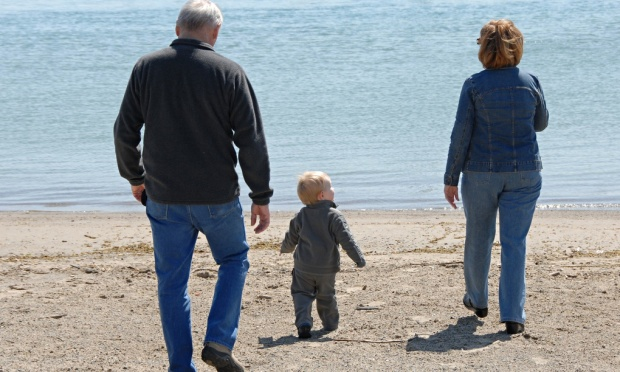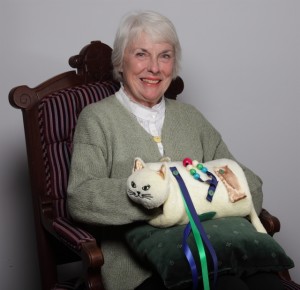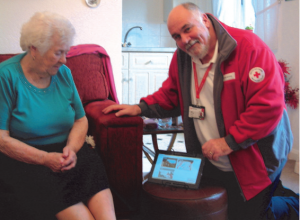 Dell has announced that Visbuzz, a burgeoning software-as-a-service start-up, has selected Dell to deliver one-touch communication technology to the elderly, who may be isolated or suffer from restricted mobility. The software, available through the cloud on Dell tablets, will offer a single-function tool to connect people quickly and efficiently with those who matter most, from family and friends to carers.
Dell has announced that Visbuzz, a burgeoning software-as-a-service start-up, has selected Dell to deliver one-touch communication technology to the elderly, who may be isolated or suffer from restricted mobility. The software, available through the cloud on Dell tablets, will offer a single-function tool to connect people quickly and efficiently with those who matter most, from family and friends to carers.
Tell me a little bit about your background?
I trained as an engineer and spent 15 years in heavy engineering (power stations and oil exploration) until I decided I wanted to be master of my own destiny. I formed my first business in 1985 and my most recent one in 2011.
Over the last 29 years, I’ve established and built businesses for myself as well as for others. I’ve raised millions in venture capital and disposed of growing business for large earnings multiples on earnings and shareholder ROI. I’ve had my set backs and hard learning experiences as have most entrepreneurs and these have always served me well going forward.
I see myself as always being involved in enterprise in some way because I love everything there is about taking ideas and making them a reality. This is especially true when the ideas are geared towards improving people’s lives and are to the benefit of communities both regionally as well as globally.
That said, it’s not all about just running a business. I have my early stage tech business (Visbuzz), but also coach 12 business leaders every month to help them get better results. I run leadership, sales and personal growth workshops for executives and I support a number of charities with their events and fundraising efforts. Luckily my partner, Elaine, supports me fully in my activities as I support her in hers.
It’s a full life and a fun life, and I adhere to Walter Hagen’s advice “…and be sure to smell the flowers along the way”
What was the inspiration for Visbuzz?
My mother is 87, immobile and yet highly independent. None of her kids live near her anymore and once my Dad died a few years ago her purpose for living declined. Adding to this the obvious isolation and exclusion, and we soon observed a downward spiral in attitude, health and mental wellbeing.
I had to find a way of including her in family and community life, raise her self-esteem and help all of us kids and grandkids stay connected. The cost and inconvenience of numerous weekly long drives for only a few minutes of face-to-face Mum time made me consider if I knew of someway I could use technology without her needing to.
Knowing what is possible and building it are two completely different things, especially when the recipient has never seen nor used a computer (as she knows it). The struggle for the absolute simplicity was agonizing. I brought in some old colleagues from the tech world and we tried a number of solutions. Finally, after 3 months, we arrived at a prototype. We then took about 21 months to get it simple enough for my mum to use, taking out the psychological barriers for her as well.
Our vision was to help create a world in which loneliness doesn’t exist, by making video calling really simple for people who can’t, don’t or won’t use computers. We now have a simple system allows users to make a call with a single touch. It actually looks like my Mum’s favourite photo frame and all she does to have a video call with me is touch my photo. It as simple as that.
Currently we run Visbuzz on Dell Venue Pro 8-inch tablets and the system works brilliantly. In a relatively short time, we’ve seen unbelievable results, not only for us but also for my mum’s carers, the GP and the NHS.
We now have customers in a number of areas in the UK successfully using Visbuzz. It’s rewarding to see the impact we are making in this area.
Why did you decide to partner with Dell?
I knew we needed a strong tech partner for this project. We had the idea, we had the developers but nothing was going to get traction like a reliable, robust bit of kit on the ground that reflects our values and our customer’s needs. This might sound a bit fluffy, but it was critical to our success.
I searched the market and was impressed by Michael Dell’s re-entry into the start-up market by essentially buying back the company he started nearly 30 years ago. I talked to a number of people at Dell and was incredibly impressed with how much time they were prepared to invest in my business and me at this very early stage. Like any new partnership, I still have to investigate Dell’s ability to deliver. We set up a few trials, which worked really well, for both of us.
We now have a partnership with Dell where Visbuzz devices are shipped directly to our customers and, more importantly, they work straight out of the box. Dell OEM have helped us develop a standard image and operating structure that simplifies our product so that as soon as you log onto your WiFi, then you’re ready to go with Visbuzz.
What does this collaboration entail?
Dell has really helped us in all areas of our technical development for Visbuzz and they are now starting to help us with its promotion. Specifically Dell has helped us with making the best use of the latest technology, such as Windows 8.
We are fortunate to be a part of the Dell Founders 50 cohort, which is a two-year program focused on key areas of growth for member companies and have access to support including technology, sales enablement, marketing, capital and networking opportunities. It’s a fantastic opportunity for us to network with other high-growth tech businesses at all stages in their journey at a global level and have access to
Tell me a bit about Visbuzz’s potential in the health sector?
Where do I start? Visbuzz has the capability to reduce isolation and loneliness. That’s how we started and that is still our vision. However, the consequences of this are so huge that the numbers are meaningless in comparative terms. There are millions of people in the UK who are isolated and lonely and, as a result, a huge burden on themselves, their families, communities and the state. Recent studies show that 25 per cent of elderly patient appointments with a doctor are because they are lonely.
A single hospital admission costs at the very least three times the first year cost of a fully functional Visbuzz and over ten times the cost of an annual Visbuzz subscription. So on hospital admissions alone for the millions of elderly and isolated each year the savings to the state are substantial. Add in the other savings such as time and cost with remote consultations with those who can’t use Skype or FaceTime, and the financial benefits sky rocket.
In addition, we haven’t touched the benefits to the communities such as those that suffer from arthritis, MS, dementia, paraplegic or quadriplegic.
With that, not only can Visbuzz help reduce the cost burden of isolation, exclusion and loneliness it will also improve connection and happiness for the user and those that matter most to them.
Where do you hope to see Visbuzz in five years?
I see Visbuzz being used throughout the NHS and privately as a main stay of communication with those who can’t, don’t and won’t use computers at whatever age or ability.
I would hope that we are still partnering with Dell and also with a partner that has an established longer-term relationship with the NHS. I do foresee our growth being limited somewhat by the inherent barriers we’ll face selling in to the public sector. Having said that I find everyone I talk to in the NHS eager and willing to help. It’s the systems that slow everything up and it’s frustrating for everyone.
And finally, what advice would you give to entrepreneurs?
Make sure you are always looking to BEFITA for Entrepreneurship.
B = Belief – believe in yourself, your idea and maintain that belief. If you don’t believe in you and your vision you can’t expect others to.
E = Energy – you must maintain high levels of energy. This requires you to be physically fit (ish) and mentally fit. Plus you need to make sure you nourish your mind and body correctly. You are always in life-long-learning mode.
F = Focus – focus, focus and focus. Maintaining focus is absolutely key for you. For all the best reasons in the world others will want to distract you and you must be steadfast. Beware feature creep at all costs. If I’d lost focus then Visbuzz would not be the simple system it is today.
I = Intention – you must have an ultimate leader’s intention. That is – where are we heading. You must also plan in detail to identify possible routes. However, no plan has ever survived an encounter with a customer, a supplier or staff. Agility is key and to be agile you need to know your ultimate intention.
T = Tenacity – tenacity is key to helping with energy and focus and vice versa. Keep going and then keep going some more. People want to know that you’re around for the long haul. They want to know you’re not going away. Be tenacious.
A = Awareness – It’s easy to become internally obsessed and driven. You will need to influence a lot of other people to follow you in your vision. Peter Drucker said “There’s only one definition of a leader – someone who has followers”. Only be maintaining your awareness of others, their needs and their drivers will you do this.
After saying all that – it’s dead easy…Compelling Vision – Great People – Massive Energy.
See the full interview here.



















 No older person should spend Christmas Day alone if they don’t want to and that’s why this year The Royal Voluntary Service has joined forces with Community Christmas to help older people who’d otherwise be on their own to find a local event where they can share a celebration.
No older person should spend Christmas Day alone if they don’t want to and that’s why this year The Royal Voluntary Service has joined forces with Community Christmas to help older people who’d otherwise be on their own to find a local event where they can share a celebration.
 Dell has announced that Visbuzz, a burgeoning software-as-a-service start-up, has selected Dell to deliver one-touch communication technology to the elderly, who may be isolated or suffer from restricted mobility. The software, available through the cloud on Dell tablets, will offer a single-function tool to connect people quickly and efficiently with those who matter most, from family and friends to carers.
Dell has announced that Visbuzz, a burgeoning software-as-a-service start-up, has selected Dell to deliver one-touch communication technology to the elderly, who may be isolated or suffer from restricted mobility. The software, available through the cloud on Dell tablets, will offer a single-function tool to connect people quickly and efficiently with those who matter most, from family and friends to carers.












